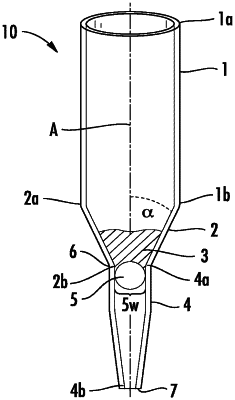| CPC B01D 15/3809 (2013.01) [B01D 15/12 (2013.01); B01D 15/14 (2013.01); B01D 15/22 (2013.01); B01D 15/424 (2013.01); B01L 3/5023 (2013.01); B01L 3/0275 (2013.01); B01L 3/5021 (2013.01); B01L 2200/0631 (2013.01); B01L 2200/0668 (2013.01); B01L 2300/0681 (2013.01); B01L 2300/069 (2013.01); B01L 2400/0409 (2013.01); B01L 2400/0433 (2013.01)] | 5 Claims |

|
1. A method of performing an affinity isolation and purification procedure, the method comprising:
adding a sample fluid comprising a target analyte to a reservoir of a device that comprises an internal structure that comprises the reservoir, a well, a fluid passageway, sorbent particles, and a filter element that blocks passage of the affinity sorbent particles, wherein the affinity sorbent particles contain immobilized affinity ligands bound to their surfaces and the affinity ligands include polymer imprinted materials and oligosaccharides; the reservoir having a first volume, a first end and a second end, the first end having a first opening for receiving fluids and the second end having a second opening that opens into the well such that the well and the reservoir are directly adjacent to each other; the well having a second volume, a length, a first end closest to the reservoir, and a second end closest to the fluid passageway, the well having a first internal width at its first end that is greater than a second internal width at its second end; the fluid passageway having a first end closest to the well and a second end comprising an outlet; the filter element positioned at the first end of the fluid passageway; and the affinity sorbent particles forming a sorbent bed within the well, the sorbent bed being positioned adjacent to the filter element and at least partially filling the well; wherein there is no filter element positioned between the reservoir and the well that blocks passage of the affinity sorbent particles;
dispersing the affinity sorbent particles in the sample fluid for a time sufficient for the target analyte to bind to the affinity sorbent particles;
removing the sample fluid from the device through the second end of the fluid passageway, forming a settled bed of loaded affinity sorbent particles having bound target analyte;
adding a washing solution to the reservoir, the washing solution causing unbound substances to be removed from the loaded affinity sorbent particles in the settled bed, without removing the bound target analyte;
removing the washing fluid from the device through the second end of the fluid passageway, thereby removing unbound substances from the settled bed;
adding an elution fluid to the reservoir, the elution fluid causing the target analyte to become unbound from the loaded affinity sorbent particles in the settled bed; and
removing the elution fluid from the device through the second end of the fluid passageway, thereby removing purified target analyte from the settled bed.
|